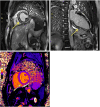Top 2024 Images in Cardiothoracic Imaging
- PMID: 39611755
- PMCID: PMC11683202
- DOI: 10.1148/ryct.240415
Top 2024 Images in Cardiothoracic Imaging
Conflict of interest statement
Figures



References
-
- Consul N , Li P , Lennartz S , Chernyak V . 2023 Top Images in Radiology: Radiology In Training Editors’ Choices . Radiology 2024. ; 310 ( 1 ): e233112 . - PubMed
-
- Lennartz S , Li P , Consul N , Lee SI . 2022 Top Images in Radiology: Radiology In Training Editors’ Choices . Radiology 2023. ; 306 ( 2 ): e229031 . - PubMed
Publication types
LinkOut - more resources
Full Text Sources

